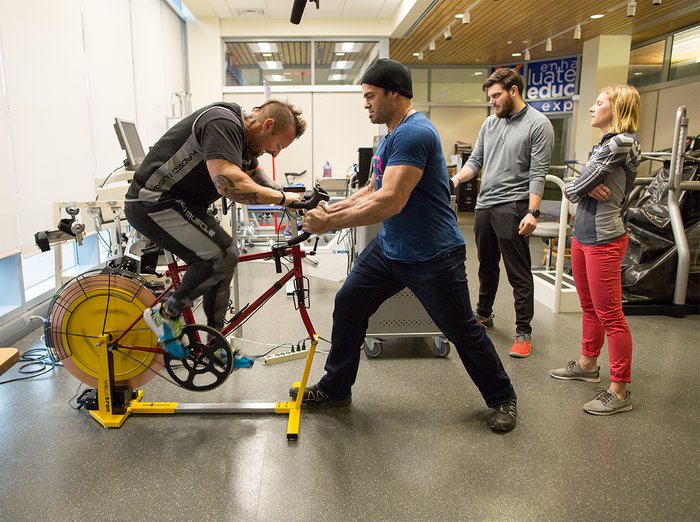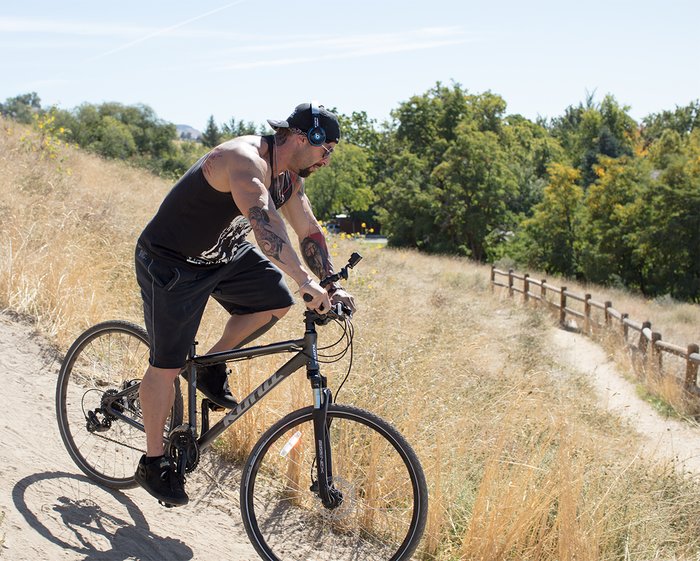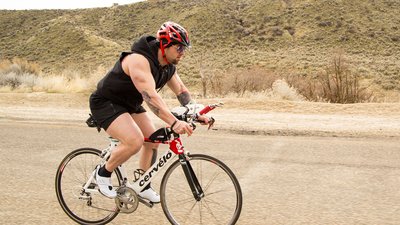Riding your bike around town or going for a quick spin is one thing. Cycling for competition or long-distance performance is another species entirely, as I've discovered firsthand as I prepared for a 112-mile full Ironman triathlon this year.
Want to make it even more serious? Try cycling when you're a heavily muscled athlete who looks more like a bodybuilder than a Tour De France racer. Just like with running, which I discussed in the article "What Every Bodybuilder Needs to Know About Running," your size can quickly begin to work against you—unless you have the right approach.
During my race preparation, I went through an intensive learning process to master not only cycling technique, but also the choices and habits that make all the difference for muscular athletes. I wanted to prove that it's possible to both carry muscle and thrive in endurance sports, and I've found that it definitely is!
Today is my opportunity to share this information with you. You can watch me put these lessons in action in the Man of Iron video series, but if you're itching to become a hybrid athlete on the bike, read this!
Get the Right Bike, Bars, and Saddle
As with any equipment, a bike works best when it is properly fitted to your dimensions and needs. This includes your body weight! As a muscled athlete, finding the right ride is going to be particularly important when selecting the bike, especially if you're going to use it for long-distance endurance bike events.
If you're using aero bars they will usually need to be fitted wider because your shoulders and chest likely won't allow you to tuck your forearms in flat like smaller-sized endurance athletes do. Trust me: You'll be thankful for the wider bars as your training progresses.

For extra comfort, my recommendation is to try several saddles until you find the one which gives enough padding and support. This is true for anyone getting serious about cycling, but especially someone with large legs and a heavy upper body.
Fuel for Your Size
Having larger legs than the average cyclist comes with its advantages and challenges. On the plus side, you have strength and power for days, and may be more able to withstand the pain of lactate buildup after all those brutal leg days you've survived. The downside is there is more muscle density and weight within the lower half of your body, which translates to more oxygen usage and greater calorie needs than a smaller athlete.
The analogy I like to use is a gas-guzzling Mustang powered by a V8, versus an efficient hybrid car. One has more power, but it also uses fuel more quickly when you step on the accelerator, and leaves you in danger of running on empty sooner. Cyclists love to talk about the "power to weight ratio," a performance marker they usually strive to improve in two ways: by doing more power-focused training, and by losing weight.
But what if you don't want to lose weight? What if, like me, you'd like to be fast on the bike while also adding muscle, burning fat, and looking like a bodybuilder? You can do it. But it won't happen by accident.
A larger athlete can burn as many as 300-500 calories per hour. Factors like headwinds and inclines will determine how far up this scale you go. If you're going to be out on the road for a long ride or race, you'll need lots of calories.
I gave a complete rundown of my race-day supplement and nutrition protocol in the article "How to Supplement for Endurance Sports," but here's the quick-and-dirty version:
- "On the go" energy like dried fruit and Manuka honey
- Nutrient-rich, food-based bars
- Quality protein supplements such as Re-Kaged
Think protein shakes are just for after the gym? I beg to differ. If you're going to be a hybrid athlete, don't be surprised if you end up consuming more protein than you did just as a lifter!
Hydration is something you're also going to have to consider, with your hourly needs being somewhere between 20-32 ounces, depending on climate and intensity. You don't want to over-hydrate to the point of diluting your body's electrolytes and minerals, because this can cause cramping and ruin your performance. Obviously, not being hydrated enough causes the same issue, along with terrible performance. The solution is to hydrate, but also take in adequate electrolytes, such as those in Kaged Muscle Hydra-Charge.

Head for the Hills
Believe it or not, your extra weight can be an advantage and help you cover ground faster on the flats and going downhill. However, this advantage ceases the minute you start up an incline. You're hauling more weight uphill, period, which means you'll be working harder than someone lighter.

No, this doesn't mean you should simply coast on the flats forever, it means you need to target the hills in your training from the start. To get your legs and cardiovascular system adequately conditioned for prolonged inclines on your bike, I'd recommend following the below weekly training sequence, as I did leading up to my Ironman:
Week 1: Cycle up a hill for 0.5 miles then back down, repeating this for a total of six times to reach a total of 3 miles.
Week 2: Cycle up a hill for 0.5 miles then back down, repeating this for a total of eight times to reach a total of 4 miles.
Week 3: Cycle up a hill for 0.5 miles then back down, repeating this for a total of ten times to reach a total of 5 miles.
Once you become more conditioned following this sequence, start adding the shorter 3-mile sequence to the back of any long-distance flat rides you do. Then, progress to the 4-mile sequence the next week, again tagging it onto the back of your long-distance ride.
The aim is for you to be able to complete the 5-mile sequence at the end of a 3-4-hour ride. By doing this at the end of your ride when your legs are heavily depleted, you know they are conditioned if you can complete it.
I often did this at the end of my leg day, but that may be too much for many of you, at least at first. You could also do it on a non-competing body-part training day, such as shoulders, as long as you're adequately recovered for any long weekend ride you plan to do.
Stop Tensing!
Old habits die hard, but you're going to have to kill a few of yours in order to make a successful transition to an endurance cyclist from a full-time bodybuilder. First and foremost, you'll need to dial back the tension!
Weight training teaches your neurological connections to recruit muscle fibers at every opportunity. This is great for building muscle, and really bad for energy conservation during an endurance bike ride. You need to rewire the brain to not tense during your cycle. It's common to tense the core muscles, along with the neck, chest, arms, grip, forearms, and even face.
Doing this will cause you to expend more energy and invite fatigue to sabotage your performance. Be conscious of this and let your body relax!
Get on the Bike
I make it sound difficult, but honestly, I found cycling to be the easiest of the three triathlon disciplines for my body to adapt to. It's also incredibly rewarding and worth your time to learn, no matter how much experience (or lack thereof) you have.
Go ahead and use the advice I've given to improve your cycling ability and general aerobic fitness, no matter if you're aiming for a specific race, or just trying to get the most out of your daily cardio on any of my programs. This will have a lot of positive effects on your life and weight training, rewarding you with improved endurance, recovery, and the ability to boost your lifting intensity.
My passion is to show you how to have it all: physical fitness and aesthetics. When you're ready to prove the world wrong and show what you're capable of, try following my Man of Iron video trainer.

